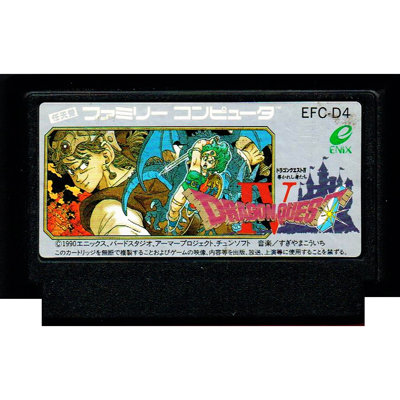DRAGON QUEST IV FAMICOM
DRAGON QUEST IV FAMICOM - EFC-D4
FUNGERAR PÅ JAPANSK ELLER REGIONSFRI ENHET
Dragon Quest IV: Chapters of the Chosen is a role-playing video game and the fourth installment of the Dragon Quest video game series developed by Chunsoft and published by Enix (now Square Enix). It was originally released for the Famicom on 11 February 1990 in Japan. A North American version followed in October 1992, and would be the last Dragon Quest game localized and published by Enix's Enix America Corporation subsidiary prior to its closure in November 1995, as well as the last Dragon Quest game to be localized into English prior to the localization of Dragon Warrior Monsters in December 1999. The game was remade by Heartbeat for the PlayStation, which eventually was available as an Ultimate Hits title. This was followed with a second remake developed by ArtePiazza for the Nintendo DS, released in Japan on 22 November 2007. This remake was released in Australia on 11 September 2008, in Europe on 12 September 2008 and in North America on September 16, 2008. A version based on the Nintendo DS remake for Android and iOS was released in 2014.
Dragon Quest IV differs from the rest of the series by breaking up the game into five distinct chapters, each of which focuses on a different protagonist or protagonists. The first four are told from the perspective of the Hero's future companions and the fifth one, from the hero's perspective, brings all the characters together as they start their journey to save the world. The PlayStation remake adds a sixth chapter, which is retained in the DS remake.
Dragon Quest IV offered several new features over the first three titles, while carrying on many of those introduced in the previous games.Similar features included are the day and night cycles, the ability to travel via ship and a flying vehicle (this time, a hot air balloon), and the three levels of keys. They are Thief, Magic and Ultimate (originally localized as Final). There are also travel doors, which allow the party to move a great distance on the world map with little travel. Unlike the Hero in Dragon Warrior III, the Hero of Dragon Quest IV is not required to be in the party at all once the wagon becomes available. Despite this, the Hero is again the character that possesses the most powerful healing and attack spells. Many spells, weapons, armor, and shops (including the vault/bank) function the same as in past games.
In addition to the new chapter-based storylines, an artificial intelligence system called "Tactics" was implemented that allowed the player to provide strategies to the party members (who become NPCs in the final chapter), such as prioritizing damage, healing or MP conservation, while maintaining full control of the Hero. Dragon Quest V: Hand of the Heavenly Bride, Dragon Quest VI: Realms of Revelation and the remakes of IV allow tactics to be set for characters individually rather than using one tactics mode for all characters, as well as including the "Follow Orders" Tactics mode, which allows other characters to be controlled manually. This "Tactics" system is seen as a precursor to Final Fantasy XII's "Gambits" system.The wagon, first introduced in this game, allows the player to choose which characters are used in battle. The wagon can also be seen in Dragon Quest V and Dragon Quest VI. The first casino appears in this installment as a place to play several mini-games (slot machine, poker, and the Monster Betting that was introduced in Dragon Warrior III) using tokens that could be traded for special items. Searching drawers and inside of jars was first introduced in this game as a means to find items. Small Medals, later Mini Medals, were introduced as a new item to search for and trade for special unique items from a secluded king.
Saving the game was made easier by allowing one to save a game in a House of Healing, rather than talking to a king.Also, the save ("Confession" in the DS remake) and EXP point to the next level-up ("Divination" in the DS remake) are now separate commands. Returning to the format of the original North American Dragon Warrior, programmers allowed users to open a door using a command appearing in the top level of the menu (rather than requiring users to search through various characters' inventories for the key as in some previous games). The only requirement was that at least one character in the party needed to have an appropriate key in his or her inventory. Since this command was added, an unlocked door was added in this game, as well as large Castle Doors. However, this command was eliminated in later games and the remake, in which doors can be opened by attempting to walk through them.
ENDAST KASSETT

